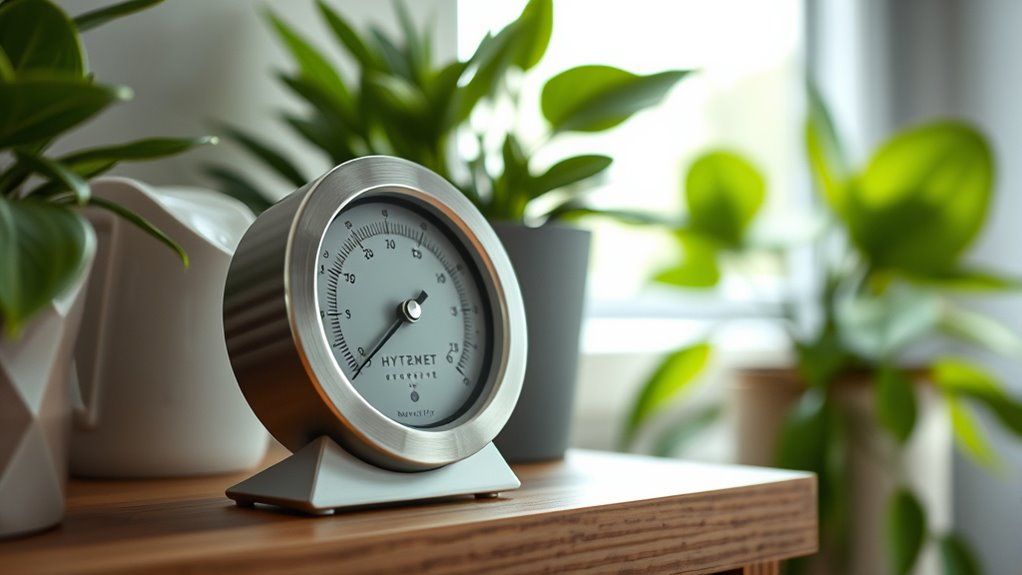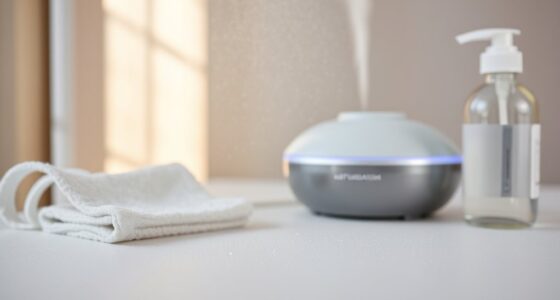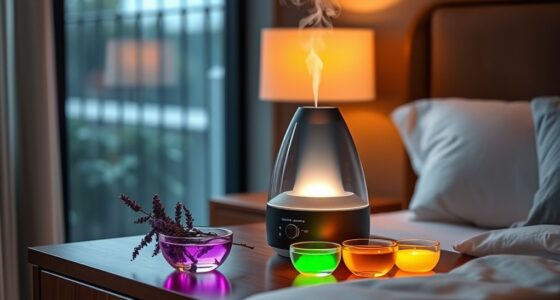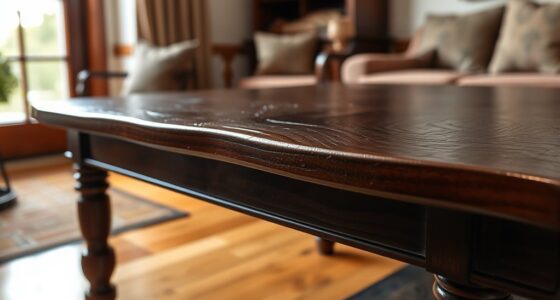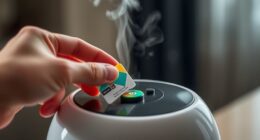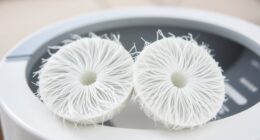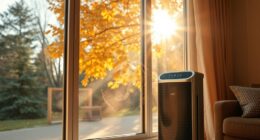Using a hygrometer helps you accurately monitor your home’s moisture levels, so you can adjust humidity for ideal comfort, health, and preservation. By checking the readings regularly, you can easily tell if your indoor environment is too dry or too humid. This allows you to make small adjustments, like adding a humidifier or opening windows. Keep an eye on those numbers, and you’ll create a healthier, more comfortable space—details that can make a big difference will become clearer as you continue.
Key Takeaways
- Use a hygrometer to monitor real-time indoor humidity levels accurately.
- Maintain humidity between 40-60% to support plants, furniture, and health.
- Adjust humidity with humidifiers, dehumidifiers, or water trays based on hygrometer readings.
- Regularly check your hygrometer to detect and address moisture imbalances early.
- Consistent humidity monitoring helps prevent damage to home items and promotes comfort.
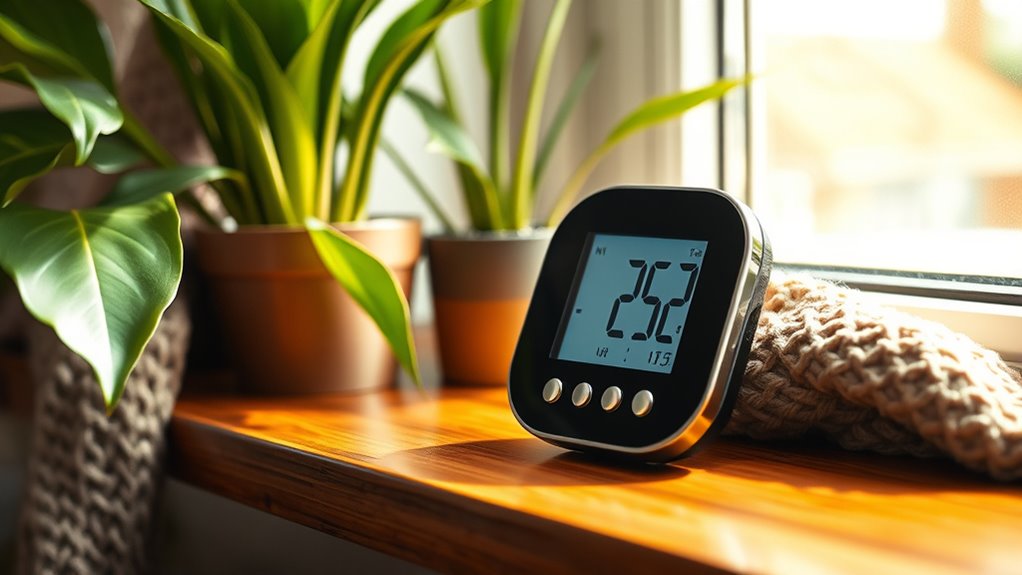
Maintaining the right humidity level in your home is essential for comfort, health, and protecting your belongings. When humidity levels are off, you might notice indoor plants suffering, furniture cracking, or respiratory issues becoming more frequent. Using a hygrometer helps you monitor these levels accurately, so you can make informed adjustments. Many homeowners overlook the importance of proper humidity, assuming that indoor air is naturally balanced, but indoor environments often fluctuate due to weather, heating, or cooling systems. That’s where a hygrometer comes in handy, giving you real-time data on your home’s moisture content.
Proper humidity is vital for home comfort, health, and protecting your belongings.
If you have indoor plants, keeping humidity levels in check becomes even more critical. Many popular houseplants thrive in specific humidity ranges, typically between 40% and 60%. Too dry, and they may develop brown leaf tips or become more susceptible to pests; too humid, and they risk fungal infections. With a hygrometer, you can precisely measure the moisture in the air and adjust accordingly. For example, if your readings show low humidity, you might add a humidifier or place water trays near heating sources to increase moisture. Conversely, if levels are too high, ventilating rooms or using a dehumidifier can restore balance quickly. Regularly tracking humidity levels ensures your indoor plants stay healthy and vibrant, and it prevents over- or under-watering your environment.
Beyond plants, maintaining proper humidity levels protects your home’s structure and belongings. Wood furniture, flooring, and musical instruments all respond negatively to excessive dryness or dampness. When the air is too dry, wood can crack or warp; if it’s too moist, mold and mildew can develop, damaging surfaces and creating health hazards. A hygrometer helps you catch these issues early by alerting you to changes in moisture content, so you can take prompt action. This proactive approach saves you money and preserves the integrity of your home. Incorporating hygrometer readings into your regular home maintenance routine can help you better understand the fluctuations and triggers affecting your environment.
Adjusting humidity levels based on your hygrometer’s readings is straightforward. If the gauge indicates dryness, use a humidifier to add moisture; if it shows excess moisture, turn on exhaust fans or open windows. Small changes can have a significant impact on your indoor environment, making it more comfortable and healthier for everyone. Investing in a hygrometer gives you peace of mind, knowing you’re in control of your home’s moisture content. You’ll find that with consistent monitoring, you can maintain ideal humidity levels effortlessly, creating a more balanced, inviting atmosphere for yourself, your indoor plants, and your belongings.
Frequently Asked Questions
How Often Should I Calibrate My Hygrometer?
You should calibrate your hygrometer at least once a year to guarantee accuracy. Regular calibration helps maintain a reliable calibration schedule and guarantees precise humidity readings. Additionally, perform accuracy verification by comparing your hygrometer’s readings with a known standard, especially if you notice discrepancies. If it’s off, recalibrate immediately. Consistent calibration and verification keep your hygrometer functioning correctly, helping you maintain perfect humidity levels in your home.
Can a Hygrometer Measure Temperature as Well?
A hygrometer primarily measures humidity, but some models also include temperature measurement. If your device has a built-in thermometer, it can give you accurate temperature readings, helping you monitor your home’s climate. Keep in mind, device accuracy varies among models, so check your hygrometer’s specifications. Using a multifunctional device can simplify monitoring both humidity and temperature, ensuring a comfortable and healthy home environment.
What Is the Ideal Humidity Level for a Nursery?
You want to maintain the ideal humidity level for nursery comfort and baby health, which is typically between 40-60%. Keeping humidity within this range helps prevent dry skin, congestion, and respiratory issues. Use a hygrometer to monitor levels regularly, adjusting with a humidifier or dehumidifier as needed. Staying within this range creates a safe, comfortable environment that promotes your baby’s well-being and restful sleep.
How Do Outdoor Conditions Affect Indoor Humidity Readings?
Imagine your home as a sponge soaking up or releasing moisture. Outdoor temperature fluctuations and seasonal humidity changes act like the weather’s breath on your indoor air, making readings fluctuate. Cold air holds less moisture, while warm air can carry more. This dynamic dance means you might see higher humidity in summer or lower in winter, so you’ll need to adjust your hygrometer or humidifier accordingly to keep indoor comfort steady.
Are Digital Hygrometers More Accurate Than Analog Ones?
You might wonder if digital hygrometers are more accurate than analog ones. Generally, digital models offer better sensor accuracy and are easier to read. However, calibration techniques are vital for both types; regular calibration ensures consistent readings. Analog hygrometers can be reliable if properly calibrated, but digital ones often provide more precise and consistent measurements, making them a better choice for maintaining perfect indoor humidity.
Conclusion
Just like a skilled sailor uses a compass to navigate stormy seas, monitoring your home’s humidity with a hygrometer guides you toward a comfortable, healthy space. By keeping an eye on those numbers, you guarantee your home stays balanced—never drifting into damp misery or dry discomfort. Remember, the right humidity isn’t just a number; it’s the steady hand steering your household through life’s unpredictable weather. Trust your hygrometer, and let it be your internal compass.
